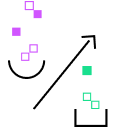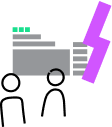At PoC, we leverage a proven design process and diverse methodologies to tackle even the most complex business, design, and product challenges with precision and impact.
We follow a structured, results-driven design process that transforms ideas into meaningful, user-centered solutions. Guided by our expertise, and integrated with your team, we go through five key steps—Understand, Ideate, Define, Prototype, and Validate—ensuring every decision is rooted in research, creativity, and practicality.
We adapt our process to fit your unique needs, tailoring each phase based on your challenges, resources, timeline, and goals. Explore the process below to see how our methodology turns your vision into reality.
Whether it’s creating engaging solutions, designing for user needs, or aligning with your business strategy, our focus is on helping you deliver the best possible product for your users.
PoC’s process was a game-changer for us. Their collaborative approach and constant feedback helped us built a product that exceeded expectations. Truly incredible partners!
Alex Turner, VP of Product at Agrodrone

We work as an extension of your capabilities. Our first step is to deeply understand your product by learning about the problems you’re trying to solve, your structure, and your audience. This helps us build a solid foundation for the work.
Together with your team, we brainstorm and create wireframes, user interfaces, and design concepts. These ideas are informed by user research and focused on solving your challenges in a way that aligns with your business objectives.
We move from sketches to high-quality designs and prototypes, ensuring they’re optimized for user needs. Our team works closely with yours to ensure every detail is carefully thought out and aligns with the overall product strategy.
Throughout the engagement, we offer constant feedback, collaborate on decision-making, and make sure everything stays aligned with your product’s vision, goals, and user requirements. We act as true partners in shaping the best solutions for your business.
As we create solutions, we ensure they fit into your development process. Our designers and product managers will collaborate closely with your team, offering expert guidance, ensuring alignment with the strategy, and assisting in building.
We support you in delivering a product that is engaging, impactful, and user-focused. We ensure it meets the needs of your users and business objectives while also helping you prepare for next steps, whether it’s launching, improving, or scaling.
Below is an overview of the design process, which consists of key phases applicable to any design project. These phases can be adapted to fit the scope and timeline of your project—whether it’s a year-long initiative for a large product or a one-week sprint for a small feature.

Learn what’s the most important problem to solve, define the objectives for the work and align on a roadmap.
The first step of the design process is Understanding, or Discovery. This phase focuses on understanding the problem, aligning on goals, and gathering all the necessary information to set a strong foundation for the project. Here’s what typically happens during this step:
This step sets the tone for the entire design process, ensuring all decisions are informed by research and aligned with the project’s goals.
User interviews
Expert interviews
HMW questions
CSD / KUQ Matrix
Journey Mapping
Surveys
Analytics & insights
Benchmarking
Observations

Our team and everyone involved will generate competing ideas and sketch their vision for the product.
The second step of the design process is Ideation. This phase focuses on generating creative ideas and potential solutions to address the problem identified during the Discovery phase. Here’s what happens during this step:
The Ideation phase is where creativity and strategy converge. It’s about exploring multiple possibilities, narrowing down the best ideas, and setting the stage for creating a focused, effective solution in the next phase.
5 whys
SCAMPER
10 x 10
Reverse Brainstorming
Brainstorming

The ideas will be prioritized: What’s valuable? Which solutions should will bring the most impact if invested into?
The third step of the design process is Decide / Define. This phase is about narrowing down the ideas generated during the Ideation phase and selecting the most promising solutions to move forward with. Here’s how it works:
The Decide phase ensures that your team focuses on the most effective and viable solution, providing a clear direction for the design and development process. This step bridges the gap between creativity and execution, turning ideas into actionable plans.
Constrain scenarios
Stack / Rank
Prioritization matrix
Idea auction
Affinity mapping
Happy/unhappy journeys

We’ll create a realistic simulation of the product, an interactive prototype with the most promising solutions.
The Prototype phase is where ideas and concepts take tangible shape. It’s all about creating a realistic version of your solution that can be interacted with and evaluated. Prototypes are not final products but functional representations that help bring ideas to life.
The Prototype step allows your team to visualize the solution, experiment with design choices, and prepare for hands-on feedback. It bridges the gap between theoretical concepts and practical implementation.
Paper prototyping
Wireframing
Interactive mockups
Proof of Concept
Spikes

Test and validate our hypothesis with actual users, measuring product fit and learning for the next iterations.
The Test / Validate phase is where the prototype is put to the test. This step is critical to ensure your solution resonates with your target audience and aligns with business goals. The goal is to gather insights, validate assumptions, and refine the solution.
The Test / Validate step ensures that your solution is user-centered, effective, and ready for development. By incorporating user feedback early and often, you minimize the risk of costly missteps later in the process.
Usability testing
A/B testing
User feedback
Analytics
User acceptance test
Surveys